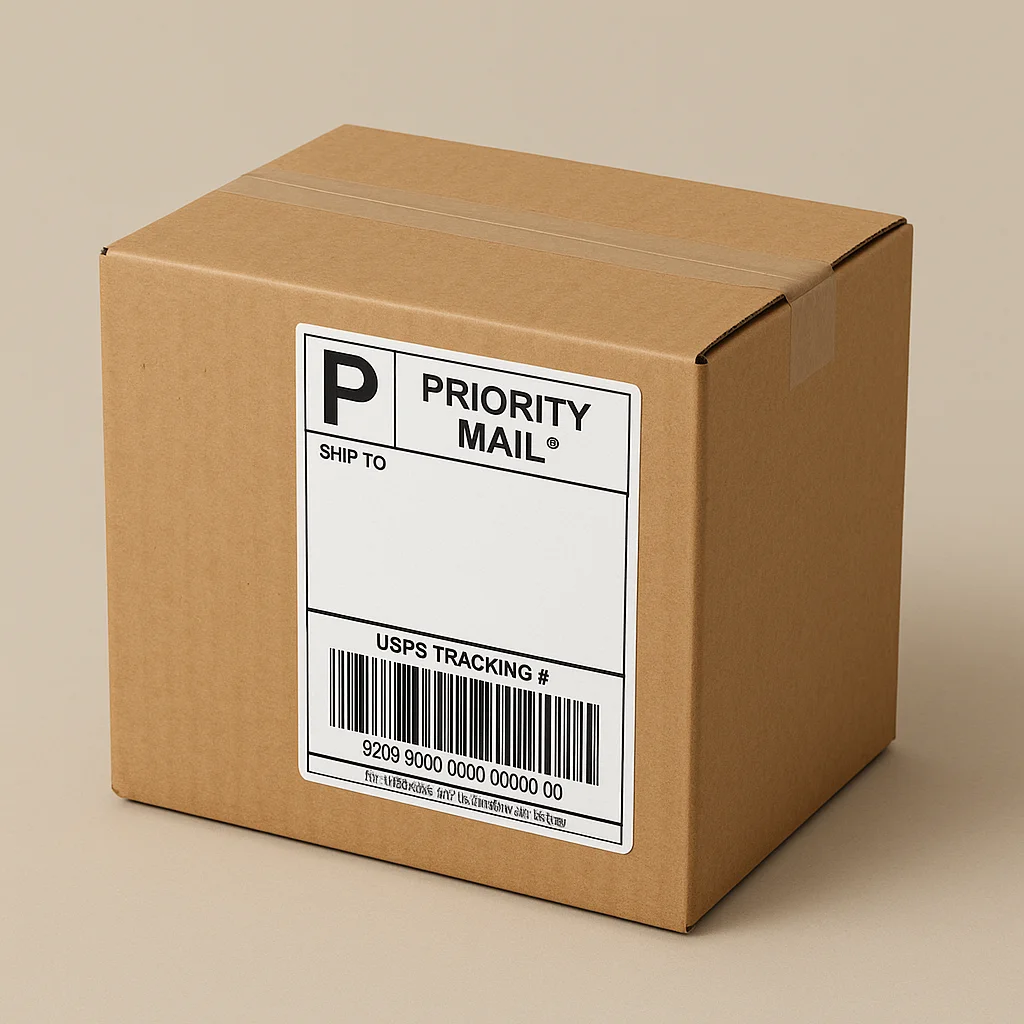Shipping with USPS Priority Mail offers speed, security, and convenience. While many shippers opt for USPS–provided flat-rate boxes and envelopes, you can indeed use your own packaging for Priority Mail shipments. This flexibility allows you to tailor your packaging to the size and shape of your items, potentially reducing dimensional weight charges and material costs. This comprehensive guide explores how to ship Priority Mail in your own box, covering packaging requirements, rate calculations, labeling, insurance options, customs for international shipments, tips for cost savings, drop-off and pickup procedures, and common pitfalls to avoid.
1. USPS Priority Mail Options
USPS Priority Mail is a domestic service offering 1–3 day delivery, depending on origin and destination. There are two main ways to ship:
- Flat-Rate Packaging
- USPS provides free flat-rate boxes and envelopes.
- You pay one fixed rate regardless of weight (up to 70 lbs) or distance.
- Weight/Zone Pricing with Your Own Packaging
- Use any box or padded envelope you supply.
- Pricing is based on actual weight, dimensional weight (if applicable), and mailing zone.
- Particularly cost-effective for light items in large boxes or heavy items in small packages.
This guide focuses on the second option: Priority Mail in your own packaging.
2. Packaging Requirements
When using your own box or envelope, your packaging must meet USPS standards for Priority Mail:
- Box Integrity: Use sturdy, corrugated cardboard or a padded envelope that can withstand handling.
- Size Limits:
- Maximum weight: 70 lbs.
- Maximum combined length and girth (2 × width + 2 × height + length): 108 inches.
- Closure: Securely seal with strong tape-USPS prohibits strings, rope, or twine.
- Cushioning: Provide sufficient cushioning (bubble wrap, packing peanuts, crumpled paper) so contents do not shift.
- External Protrusions: Avoid sharp or protruding items that may tear packaging.
By ensuring packaging integrity, you minimize risk of damage and ensure compliance with USPS handling processes.
3. Rate Calculation and Cost Considerations
When shipping in your own box, Priority Mail rates depend on:
- Weight
- You pay per pound or fraction thereof.
- Rates begin around $8 – $9 for 1 lb packages and increase incrementally.
- Zone
- USPS divides the U.S. into zones based on distance from origin zip code.
- Rates rise with the zone number (e.g., Zone 1 adjacent states vs. Zone 8 Alaska/Hawaii).
- Dimensional Weight
- Applied if package is large relative to its weight.
- Calculated as (Length × Width × Height) ÷ 166 (inches) in pounds.
- If dimensional weight exceeds actual weight, you pay by dimensional weight.
Example Calculation
- Your package weighs 5.2 lbs and measures 18″×12″×6″.
- Actual weight: 5.2 lbs (rounded up to 6 lbs).
- Dimensional weight: (18×12×6)/166 ≈ 7.8 lbs (rounded up to 8 lbs).
- USPS charges at 8 lbs for Priority Mail in your box.
Always measure and weigh accurately to avoid “postage due” assessments at drop-off.
4. Labeling and Addressing
Proper labeling ensures timely delivery:
- Shipping Label: Print via USPS.com, your shipping software, or handwrite in dark ink.
- Return Address: Include your full address in the upper left corner.
- Recipient Address: Centered on the largest flat surface; include street address, city, state, ZIP+4 code.
- Barcode Clearance: Leave a 4″×4″ clear space around barcodes.
- Special Services: Indicate Signature Confirmation, Insurance, or Restricted Delivery on the label if purchased.
Using a printed label from USPS Click-N-Ship or integrated shipping platforms yields scannable barcodes and often discounted postage.
5. Insurance, Tracking, and Added Services
Priority Mail automatically includes:
- Tracking: End-to-end tracking at no extra cost.
- Insurance: Up to $100 of coverage for loss or damage included.
Additional services (for a fee) include:
- Additional Insurance: Up to $5,000 total coverage.
- Signature Confirmation: Requires recipient signature upon delivery.
- Registered Mail: Highest security, recommended for valuables.
- Certified Mail: Proof of mailing and delivery record.
To purchase extra services, add them online when printing postage, or at the Post Office counter.
6. International Priority Mail
If shipping outside the U.S., consider Priority Mail International in your own packaging. Requirements include:
- Customs Forms: Attach CN 22 or PS Form 2976, detailing contents, value, and weight.
- Prohibited/Restricted Items: Check the destination country’s import rules.
- Insurance: Standard coverage of $100; additional insurance available.
- Delivery Time: Typically 6–10 business days, varies by country.
You pay by weight and zone; flat-rate international packaging is also available but optional.
7. Drop-Off and Pickup Procedures
After packaging and labeling:
- Drop-Off
- Bring to any USPS retail location, collection box (if package fits), or Priority Mail Express drop box.
- Hand over at counter for added services or insurance validation.
- Pickup
- Schedule free Carrier Pickup via USPS.com for packages with prepaid postage.
- Place package at your curb, mailbox, or delivery point before carrier’s arrival.
Always obtain a receipt or take a photo of the labeled package in case of disputes.
8. Cost-Saving Tips
- Comparison Shopping: Compare flat-rate vs. weight-zone rates. Flat-rate may be cheaper for heavy, dense items.
- Use Regional Rate Boxes: USPS Regional Rate A & B boxes offer lower rates to nearby zones. Can be shipped only in USPS-provided special boxes.
- Bulk Discounts: Business shippers can enroll in USPS Commercial Base or Commercial Plus for up to 40% discounts.
- Dimensional Efficiency: Use the smallest possible box to avoid dimensional weight charges.
- Batch Printing: Print labels online to save Post Office trip fees and access discounted rates.
Leveraging these strategies can reduce your per-shipment costs significantly.
9. Common Pitfalls and How to Avoid Them
- Under-estimating Dimensions
- Always measure outside dimensions for dimensional weight. Under-measurement can lead to postage due.
- Insufficient Cushioning
- Inadequate internal protection risks damage and denied claims.
- Illegible Handwriting
- Smudged or faint labels can delay scanning and delivery.
- Prohibited Items
- Avoid shipping flammable liquids, certain batteries, or other restricted items. Check USPS HazMat guidelines.
- Missing Customs Documentation (International)
- Incomplete forms cause delays in customs clearance.
By anticipating these issues, you ensure smooth processing and delivery.
10. Step-by-Step Checklist
Before shipping Priority Mail in your own box, confirm:
- Packaging is sturdy, meets size/weight limits, and is fully sealed.
- Correct weight and dimensions have been recorded.
- Postage purchased covers either weight/zone or dimensional weight.
- Label includes clear recipient/return addresses and required barcodes.
- Optional services (insurance, signature) have been added if needed.
- Package is dropped off or prepared for pickup per USPS guidelines.
- Tracking number is recorded for reference and package monitoring.
Conclusion
Shipping USPS Priority Mail in your own box combines the speed and reliability of Priority Mail with the flexibility to choose packaging that fits your needs. By understanding USPS packaging requirements, accurately calculating rates-including dimensional weight-properly labeling your shipment, and utilizing insurance and tracking services, you can ship confidently and cost-effectively. Whether you’re an occasional shipper or run an e-commerce business, following the guidelines above will help ensure your packages arrive on time, intact, and within budget.



Leave a Reply